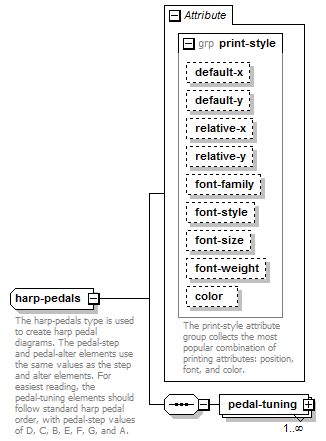harp-pedals
The harp-pedals type is used to create harp pedal diagrams. The pedal-step and pedal-alter elements use the same values as the step and alter elements. For easiest reading, the pedal-tuning elements should follow standard harp pedal order, with pedal-step values of D, C, B, E, F, G, and A. |
Complex Type Information
Model
Children: pedal-tuning

Attributes
| QName | Type | Fixed | Default | Use | Inheritable | Annotation |
|---|---|---|---|---|---|---|
| color | color | optional | ||||
| default-x | tenths | optional | ||||
| default-y | tenths | optional | ||||
| font-family | comma-separated-text | optional | ||||
| font-size | font-size | optional | ||||
| font-style | font-style | optional | ||||
| font-weight | font-weight | optional | ||||
| relative-x | tenths | optional | ||||
| relative-y | tenths | optional |
Used By
| Element | direction-type/harp-pedals |
Source
<xs:complexType name="harp-pedals"> <xs:annotation> <xs:documentation>The harp-pedals type is used to create harp pedal diagrams. The pedal-step and pedal-alter elements use the same values as the step and alter elements. For easiest reading, the pedal-tuning elements should follow standard harp pedal order, with pedal-step values of D, C, B, E, F, G, and A.</xs:documentation> </xs:annotation> <xs:sequence> <xs:element name="pedal-tuning" type="pedal-tuning" maxOccurs="unbounded"/> </xs:sequence> <xs:attributeGroup ref="print-style"/> </xs:complexType> |